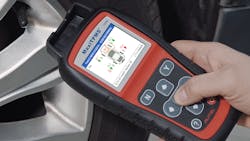There are A LOT of tools and equipment technicians need to repair vehicles, but it can be hard to keep them all straight. Especially when you need to know not only what does, but how it compares to other tools just like it. Professional Distributor is here to help! In this article, we'll be looking at TPMS tools and a few tips on how to make that sale.
1. Ask what they need
“The first thing a dealer should do is take a look around the shop they are visiting,” Autel’s national trainer, professional tool level sales manager, Michael Flink says. “Is there a tire machine in the shop? If there’s a tire machine in there, you know they have a guaranteed need for TPMS tooling.”
Understand the needs of the shop and its technicians when selling TPMS tools and equipment. Don’t assume that since a shop is buying sensors from a tire supply warehouse or a parts store they do not need a tool. Some sensor manufacturers give a free tool with their sensors, but those tools can be limited in their coverage, features, and functions. Shops may be looking for a more complete tool to round out their offerings.
“Ask what their needs are,” ATEQ TPMS Tools' aftermarket account executive, Shelia Stevens says. “What vehicles do you work on? What issues are you having with TPMS? Are you turning customers away to the dealership for TPMS service? What sensors do you work with?”
The answers to these questions will unveil both the needs of the shop and the right tool for their technicians.
2. Display and demonstrate
Display TPMS tools alongside diagnostic tools in the truck. This is a good way to get potential customers to pick up the tool and investigate. Some TPMS tools have a colorful, brightly lit display; tool manufacturers suggest having the tool turned on to attract the technicians and welcome them to navigate the platform.
The Tech400Pro’s accessory wall-mounted cradle with induction charging can double as an excellent display.
“If a dealer has the wall space on the truck, hang the tool,” Bartec USA's CEO and general manager, Scot Holloway says. “Put it up there, show it in action, plug it in, show how it works, and be ready to demonstrate it.”
The best way to encourage the purchase of a TPMS tool is to show that tool in action through demonstration. Stevens, Flink, and Holloway all suggest having programmable sensors on-hand to demonstrate the tool; or if a dealer is so inclined, get out of the truck and initiate and complete a relearn process on the truck itself, or even a vehicle in the shop’s lot.
3. Stay relevant
According to Holloway, customers should be keeping these factors in mind before buying a new tool.
- Make sure you pick a tool that you can make money with.
- It should access the vehicles you are working on and have the coverage you need to get the job done.
- Make sure you have good technical support.
The TPMS category is extensive, and with such vast variations in functions, capabilities, and coverage, selecting the proper tool can seem challenging or overwhelming. As a dealer, you can smooth this process by communicating with tool manufacturers, shops, and technicians, so that your customers understand each tool’s capabilities and they can select the tool that meets their needs. Helping shops and their technicians stay current with industry trends, changes in technology, and the ever-increasing demand for TPMS servicing will set you apart from the rest.
To learn more about TPMS tools, click here.
